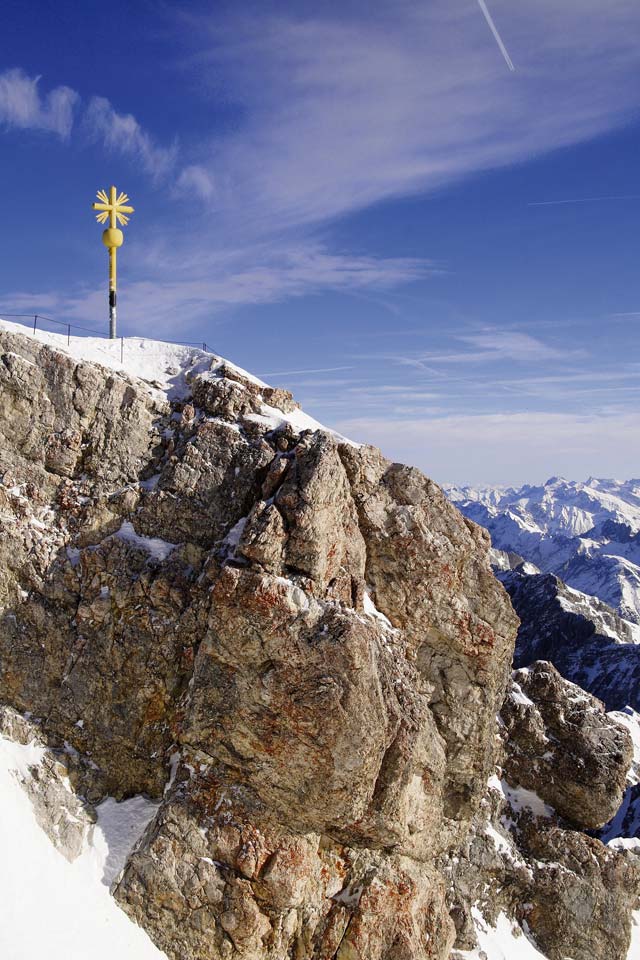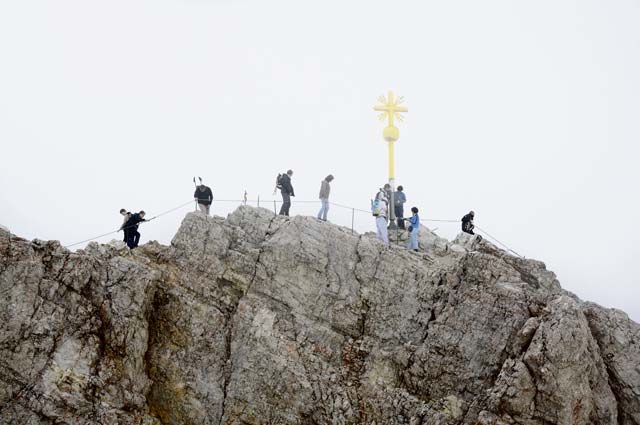
We couldn’t have asked for a more glorious day as we neared the summit of Germany’s tallest mountain.
After two days of hiking up from Garmisch-Partenkirchen through the Partnach Gorge, a gentle breeze reminded us that concentration was still needed to make it safely up the rock face the last several hundred meters to the top.
Our trip began two days earlier with train rides to Munich and on to Garmisch, where we had fortified ourselves with a hearty meal and a couple of beers before vowing to get up early the next morning to start the roughly 10-hour trek.
With the water bottles filled and our gear stashed securely in our packs, we headed out across the valley toward the site of the 1936 Winter Olympic ski jump stadium. Another 20 minutes of walking took us to the entrance of the more than 700-meter-long Partnach Gorge, where our breaths were taken away — not by the exertion, but by the awesome splendor of a mountain carved open by the gushing waters of a glacier-fed river.
From there, the views continued to dazzle as we began the initial ascent along the Partnach River up to the Bock Hut and then on through the Reintal Valley for a short lunch break at the Reintalanger Hut. It was a pleasure to sit for a few minutes, enjoy a bowl of hot soup and to get a look at some of the other hikers we would encounter again during the ensuing climb up the Zugspitze.
The bells of mountain sheep accompanied our footsteps as we began the last stretch of the day up through the Brunntal to the Knorr Hut, where we were destined to spend the night. By early afternoon we had ascended from about 730 meters (at the ski jump stadium) to 2,057 meters at the hut on the eastern edge of the Zugspitz Plateau.
For those of us who had never experienced spending the night in one of the alpine huts, it was a treat to discover they are well-supplied (by helicopter). While the sleeping conditions at the Knorr Hut are a bit like a sleepover — large bays where one shares space with other hikers both washed and unwashed — the kitchen and staff ensure guests are well-fed with traditional German fair.
We were awakened the next morning by the sun’s first rays edging their way up the valley and painting the mountain flowers, patches of snow and cliff sides with soft pastels. As we grabbed a quick coffee, admired the view and rounded up our gear, the first hikers headed up the trail eager to make summit.
The ever-present sheep, scrabbling for sparse vegetation among the rocks, accompanied us as we made our way up into the Zugspitze Plateau before beginning the final and most challenging stretch adjacent to the cable car, which runs between the Sonn-Alpin lodge and a platform at the top. As we gazed up the steep slope — some 400 meters rise in elevation of loose rock and cable-guided cliffside — we prepared for the most spectacular views of surrounding Germany and Austria.
After joining the hundreds of tourists who had arrived by cable car at the top, we made the last short climb up a ladder to the cross at the 2,962-meter mark. From the summit we could see hikers making their way up other routes and the Eibsee far below.
Our group leader, Dan Thompson, Installation Management Command-Europe public affairs officer, observed after the hike: “Reaching the summit creates a euphoric feeling of flight, camaraderie and serenity. You begin each summit with some degree of doubt, and each step skyward is a step toward overcoming both the physical and mental obstacles in your path.”
Thompson, an experienced alpine hiker who wrote the book “Following Whispers” about his adventures in the Himalayas, said hiking for him is like meditation, “aligning the mind, body and spirit to the cadence of your boot striking the trail … it’s hugely refreshing.”
While there are plenty of opportunities for hitting the trail, the Garmisch area offers a wealth of spectacular areas to explore with well-marked trails.

“You don’t have to climb Germany’s highest peak to enjoy a good hike,” said Brad Hays, marketing director with the Edelweiss Lodge and Resort. “Hiking the Hohental (another gorge in the area located above Hammersbach) is an amazing route. The Edelweiss offers the perfect base camp.”
Hays recommended hikers start with easier walks and make sure they are in good shape before tackling the Zugzpitze.
“The trails are never far away, and people can pick up maps and information at the Alpine Adventures in the Edelweiss Lodge,” he said.
Thompson admitted he was not in the best shape when he first climbed the mountain.
“A fast heart rate, shortness of breath and exhaustion are all possibilities if one hasn’t trained at least a few times a week before the climb,” he said. “One has to respect the mountain and yourself when gauging whether or not to attempt a summit. If you get winded on a flight of stairs, the Zugspitze is not for you. But the good news is that you can develop a goal-oriented fitness plan ahead of time and reward your days of pushups, running or biking with amazing views from atop Germany’s highest peak.”
Thompson pointed out that hikers should be prepared for anything — from slippery slopes due to rain or snow, gusts of wind to sunburn.
“In the summer, light rain, dampness and chilly fog are more likely at lower altitude with snow at higher altitudes,” Thompson said. “That makes it absolutely essential to pack for a variety of weather and temperatures. It adds some weight, but layering can help.”
Carrying plenty of water is also essential, although refills are possible at huts along the route.
Both Hays and Thompson said making reservations at the mountain huts, hotels in Garmisch or at the Edelweiss Lodge and Resort well in advance is recommended.
“I’d suggest a month out to ensure availability,” said Hays, saying weekends are definitely busier than weekdays.
Thompson said doing a little research, such as picking up a good map or searching online, can help one choose which hut or huts to reserve space in for a Zugspitze ascent.
“The huts are clearly marked along with their names. Once you have the names, you can search for them using Google and translate the search results automatically using Google Translate,” he said.
Thompson said emails can be used to make reservations and many lodge operators speak English.
For more information about hiking in the German Alps and arranging overnight accommodations in the mountains, visit the German Alpine Association website at www.davplus.de/huetten.
To find out more about the Edelweiss Lodge and Resort, visit http://edelweisslodgeandresort.com or search “Edelweiss Lodge and Resort” on Facebook.


